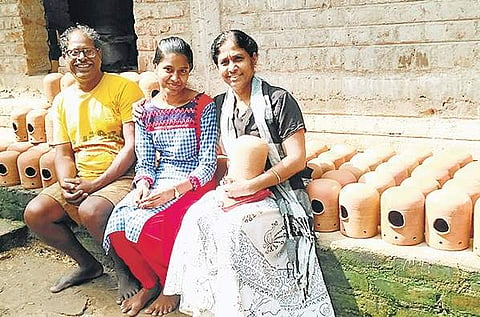

CHENNAI: They say it all starts with a question. And no one knows this better than Sadhana Rajkumar. ‘Where are the sparrows?’ — a question that Sadhana was silently seeking answers for when she asked her mother to stop fussing over their absence because ‘they must be there somewhere’.
Beginning a crusade
“I started looking out for them after that conversation with my mother and realised that she was right...the sparrows had disappeared,” she says. “I felt that like others around me, I too had not taken care of them. I started reading up about it and found that the sparrow population was declining worldwide. While many reports cited radiation to be the cause for their disappearance, I believe that it was the lack of a conducive environment for their existence, which was the prime reason. There was no food, water or place to nest which led to a decline in their population.”
ALSO WATCH | Meet Chennai's 'Sparrow Saviour' Sadhana Rajkumar
The year 2010 changed Sadhana’s life goals. The nutritionist-turned-conservationist went on a crusade to bring back the sparrows and started distributing nests — free of cost — to people in the city.
“People began to see that sparrows visited their homes within days of setting up the nest. I designed the nest in such a way that it was both economical and effective. I showed the design to potters but they refused to make it because it was cylindrical and quite complex. Finally, I approached one potter who agreed to make it and has been making it ever since. I started off with wooden nests but found terracotta nests to be far more pocket- and eco-friendly,” recalls Sadhana.
Bringing sparrows back
Her efforts have paid off. “I would say that there has been a tremendous rise in the sparrow population in Chennai. I strongly believe that if you create a conducive environment for them, they will visit you because sparrows love human habitation. They are called ‘house sparrows’ for a reason. This increase in population can be attributed to the nests in addition to the rise in terrace gardens and native plants rather than ornamental plants being sowed,” shares Sadhana.
A decline in the sparrow population, she says, is a sign of environmental degradation. “We need to save the sparrows for ourselves. A simple example is that a sparrow’s fledeglings feed on mosquito larvae and insects. Since there aren’t enough sparrows to feed on this larva, we see that the mosquito population is on the rise and along with that vector-borne diseases are too. A regular fever now takes 10 days to subside. It just points to an imbalance in the ecosystem. Bring back the sparrows for your own health,” she urges.
Catching them young
Known as the Sparrow Queen, Sadhana has distributed over 1,700 nests in nine years all over India. Her nests have travelled as far as Punjab and New Delhi, and she is getting ready to send one to Jammu and Kashmir soon.
She has initiated a dialogue on sparrows and visits various schools to make children aware of this species’ importance in the environment. She also conducts sessions to teach to make bird feeders from plastic water bottles.
“It then becomes a lesson in recycling too,” she says. “It is always good to catch them young and make them aware of the importance of the species. And I can see that I have got the children’s attention when I hear the number of questions they ask me. It is such a great feeling when I know what I said has resonated with them. I find the ‘Sparrow Queen’ title to be embarrassing. The sparrows are the real kings and queens...I am just a saviour.”
If you would like to receive a nest or be part of a WhatsApp group that has about 200 members who discuss everything under the sun about sparrows, you can contact Sadhana on 9445249240.
Feather facts
House Sparrows are closely associated with people and their buildings. You won’t find them in extensive woodlands, forests, or grasslands.
In extreme environments such as deserts or the far north, House Sparrows survive only in the immediate vicinity of people.
House Sparrows eat mostly grains and seeds, as well as livestock feed and, in cities, discarded food.
They readily eat birdseed including millet, milo, and sunflower seeds. Urban birds readily eat commercial bird seed.
In summer, House Sparrows eat insects and feed them to their young ones. They catch insects in the air, by pouncing on them, or by following lawnmowers or visiting lights at dusk.
House Sparrows nest in holes of buildings and other structures such as streetlights, gas-station roofs, signs, and the overhanging fixtures that hold traffic lights. They sometimes build nests in vines climbing the walls
of buildings.
House Sparrows are strong competitors for nest boxes, too, at times displacing the species the nest box was intended for. House Sparrows nest in holes in trees somewhat less often.
House Sparrows hop rather than walk on the ground. They are social, feeding in crowded flocks and squabbling over crumbs or seeds on the ground.
SOURCE: The Cornell Lab - All About Birds
TIPS TO ATTRACT SPARROWS
● Sprinkle millets on any free surface that the sparrows can come to. Alternatively, you could use a bird feeder.
● Provide water bowls as dehydration is another cause for the decline of the sparrow population.
● Put up the nests in your homes so they can breed and nest there.
● Grow native plants.